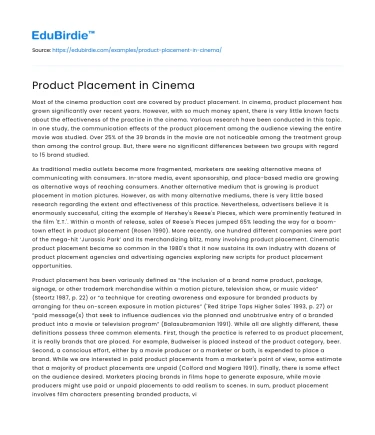Most of the cinema production cost are covered by product placement. In cinema, product placement has grown significantly over recent years. However, with so much money spent, there is very little known facts about the effectiveness of the practice in the cinema. Various research have been conducted in this topic. In one study, the communication effects of the product placement among the audience viewing the entire movie was studied. Over 25% of the 39 brands in the movie are not noticeable among the treatment group than among the control group. But, there were no significant differences between two groups with regard to 15 brand studied.
As traditional media outlets become more fragmented, marketers are seeking alternative means of communicating with consumers. In-store media, event sponsorship, and place-based media are growing as alternative ways of reaching consumers. Another alternative medium that is growing is product placement in motion pictures. However, as with many alternative mediums, there is very little based research regarding the extent and effectiveness of this practice. Nevertheless, advertisers believe it is enormously successful, citing the example of Hershey's Reese's Pieces, which were prominently featured in the film 'E.T.'. Within a month of release, sales of Reese's Pieces jumped 65% leading the way for a boom- town effect in product placement (Rosen 1990). More recently, one hundred different companies were part of the mega-hit ‘Jurassic Park’ and its merchandizing blitz, many involving product placement. Cinematic product placement became so common in the 1980's that it now sustains its own industry with dozens of product placement agencies and advertising agencies exploring new scripts for product placement opportunities.
Save your time!
We can take care of your essay
- Proper editing and formatting
- Free revision, title page, and bibliography
- Flexible prices and money-back guarantee
Product placement has been variously defined as “the inclusion of a brand name product, package, signage, or other trademark merchandise within a motion picture, television show, or music video” (Steortz 1987, p. 22) or “a technique for creating awareness and exposure for branded products by arranging for theu on-screen exposure in motion pictures” ('Red Stripe Taps Higher Sales' 1993, p. 27) or “paid message(s) that seek to influence audiences via the planned and unobtrusive entry of a branded product into a movie or television program” (Balasubramanian 1991). While all are slightly different, these definitions possess three common elements. First, though the practice is referred to as product placement, it is really brands that are placed. For example, Budweiser is placed instead of the product category, beer. Second, a conscious effort, either by a movie producer or a marketer or both, is expended to place a brand. While we are interested in paid product placements from a marketer's point of view, some estimate that a majority of product placements are unpaid (Colford and Magiera 1991). Finally, there is some effect on the audience desired. Marketers placing brands in films hope to generate exposure, while movie producers might use paid or unpaid placements to add realism to scenes. In sum, product placement involves film characters presenting branded products, visually or verbally, as part of the script or to simply have branded products used as set pieces or props.
The technique of placing branded products in Hollywood motion pictures is not new. It was used as early as 1945, when Jack Daniels whiskey was featured in the movie, ‘Mildred Pierce’ (Spillman 1985). At that time, though, studio managers may have featured brands in films through barter arrangements with manufacturers, who in turn supplied complementary products to the studio's commissary (Miller 1990). Even today, it is not uncommon for manufacturers to send cases of their products to movie studios in hopes of getting some exposure (Steortz 1987).
After the success of 'Reese's Pieces', however, product placement has become a thriving industry. By the mid-eighties, there were more than 30 companies acting as agents for products (Oliver 1986). Manufacturers pay these agents fees, such as $10,000 to $50,000 per placement, or $25,000 to $500,000 annually,or a mini- mum fee plus $1,000 for every one million national box ofice attendance (Steortz 1987). These agents seek out scripts to find acceptable placements for their clients, with 'clearly visible to the audience' being considered acceptable (Steortz 1987,p. 4).
Most films have an excellent demographic breakdown, being a prime outlet for advertisers who pursue consumers with higher discretionary income, education, and who are under the age of 35. Although the industry suffered with the introduction of television and will continue to sustain losses at the hands of cable and VCR household consumption, seeing a movie is still considered an 'event' to many moviegoers. Johnson(1981) argues that this may make the movie more memorable than other media.
An advertiser has truly captive viewers and little or no 'noise' in the communication channel. Acoustical studies used by architects ensure a quality sound presentation, bolted chairs direct viewers' attention, theater seating is cushy and comfortable, there are no commercial interruptions, and viewers generally remain in place for the entire duration of the film (Johnson 1981).
However, as a theatrical presentation, an advertiser wishing to pass along large amounts of information cannot do so effectively. Generally, the product is only glimpsed or mentioned. Robert Kovoloff, President of Associated Film Promotions (responsible for placing Wheaties in Rocky 110,denies that this is a problem, “Seeing a product, even for a second, in a realistic dramatic setting in which the viewer is already emotionally involved leaves an invaluable impression”. Marketers of the Pemer product concur, “This sort of exposure is very important to us because it's all part of getting Pemer into the fabric of society. It's a very subtle way of selling” (Clark 1988,pp. 366-367).






 Stuck on your essay?
Stuck on your essay?

